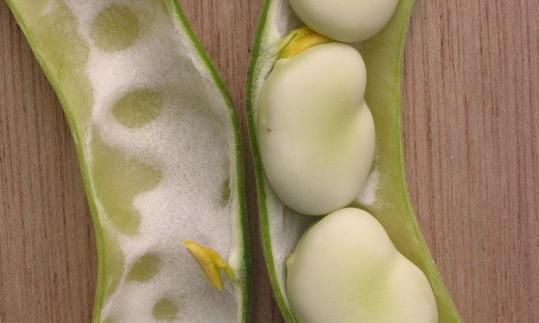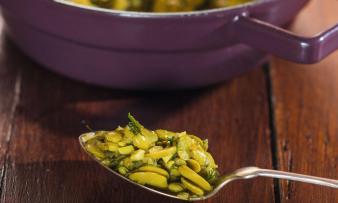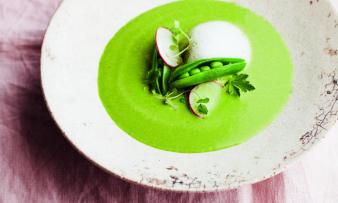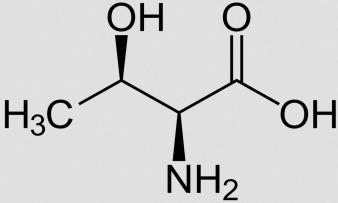Table of contents
The broad bean ( Vicia faba ), also known as broad bean or fava bean , can be eaten raw because it contains little phasin.
Use in the kitchen
The protein-rich broad bean is 1 to 2.5 cm long and 0.5 to 1 cm thick. It can be light green, reddish brown or greenish brown and some varieties have spots or dots. The bean was an important staple food for a long time until the common bean with its various varieties ( borlotti , kidney , black and white beans ) pushed it off the dinner plate.
In contrast to garden beans, fresh broad beans can also be eaten raw, as they contain little phasin. To make them easier to digest, they can be blanched or steamed briefly. Dried broad beans should be soaked in water overnight and then cooked in three times the amount of water for 40-50 minutes until they are soft.
Fava beans are particularly popular in Mediterranean and Arabic cuisine. There they are used for hearty soups, spicy stews , bean purée (ful) or patties ( falafel ). The broad beans also taste delicious in salads, for example with red bell peppers , black olives , cherry tomatoes , an oil-free salad dressing and a garnish of mint or basil . The fava beans also go well with mixed vegetables.
Vegan recipe for broad bean stew (Ful Medames)
Ingredients (for 2 people): 200 g dried broad beans, 1 teaspoon salt , 1 onion , 2 cloves of garlic , 1 green chili pepper , 1 tablespoon rapeseed oil, 2 tablespoons tomato paste , 2 teaspoons cumin , 300 ml bean water, salt ,black pepper , lemon juice , a bunch of fresh parsley .
Preparation: Soak the beans overnight. Drain the water and then rinse the beans with fresh water. Put the beans in a large pot and cook with three times the amount of water for about 40-50 minutes without a lid. 10 minutes before the end of the cooking time, season with 1 teaspoon of salt. Drain the water, but make sure to collect the bean water so that you can use it later.
Finely chop the onion, garlic cloves and chili. Put the rapeseed oil in a large pot and fry the onions, garlic and chili over a medium heat for 3 minutes, stirring frequently. Add the tomato paste and cumin and sauté for two minutes. Add the beans and deglaze with the bean water. Season with salt and pepper if necessary. Simmer with the lid closed over a low heat for 20 minutes. Mash some of the mixture with a potato masher or a fork. Arrange the bean puree on plates, drizzle with a few drops of lemon juice and garnish with parsley.
Vegan recipes with broad beans can be found under the note: " Recipes that have the most of this ingredient ".
| Not only vegans or vegetarians should read this: Vegans often eat unhealthily. Avoidable nutritional mistakes . |
Purchasing - Storage
Broad beans can usually be bought in dried form, sometimes in organic quality. Broad beans are usually not available in large supermarket chains such as Coop , Migros , Spar , Rewe , Edeka , Hofer , Aldi , Denner , Volg , Lidl and Billa . Fava beans can sometimes be bought in organic supermarkets such as Denn's Biomarkt or Alnatura , as well as in health food stores. They are more commonly found in shops with Turkish, Arabic or Italian products or via online delivery. Fresh broad beans can occasionally be found at the weekly market during their peak season ( June to August ). 6
The availability of field beans in the supermarkets mentioned varies depending on the size of the store, catchment area, etc. If you are interested, click on our recorded food prices for the DA-CH countries (above under the ingredient image). There you will find current prices from various supermarkets and their price development.
Storage tips
Fresh broad beans will keep in the fridge for three to five days, although they will stay crisper in the pod than when opened. 6 Dried broad beans can be stored for several months.
Ingredients - Nutritional values - Calories
100 g of fresh broad beans (organic) contain 341 kcal. They are rich in fiber and protein. With 25 g of dietary fiber per 100 g of beans, they cover 100% of the daily requirement. The 25 g of protein per 100 g of beans correspond to 52.2% of the daily requirement. The carbohydrate content is moderate at 58 g/100 g. The fat content is low at 1.5 g/100g. 1
Fava beans are rich in folate (folic acid) with 423 µg/100 g. 100 g of fresh broad beans cover 212% of the daily requirement. Raw black beans (444 µg), white beans (388 µg) and kidney beans (394 µg) have similar values. However, these have to be cooked, which reduces the folate content; for example,cooked black beans have 149 µg/100g and cooked white beans have 102 µg/100g. 1
The protein-rich beans contain all eight essential amino acids. Tryptophan and threonine are abundant, with 0.25 g and 0.93 g per 100g respectively. The other amino acids, except methionine , are also well represented. 1
The complete ingredients of broad beans, the coverage of the daily requirement and comparison values with other ingredients can be found in our nutrient tables. In the article Nutrients explained you will get a detailed insight into the topic.
Effects on health
Are broad beans healthy? Broad beans are very healthy due to their high folic acid content. Folic acid is involved in important metabolic reactions (DNA and RNA synthesis). Too little can cause genetic damage. Folic acid is also important for the development of the central nervous system. Folic acid is particularly important for women who want to have children. The German Nutrition Society recommends that women should increase their folic acid intake before pregnancy (requirement 600 µg) to prevent birth defects in the newborn. 20 Eating foods with a high folic acid content such as beans reduces the risk of pancreatic and colon cancer. 18 However, too many artificial folic acid preparations can increase the risk of developing cancer. 19
Can you eat broad beans raw? You can eat small amounts of broad beans raw when they are still young and soft. At that point they still contain little of the lectin phasin, a plant substance that is toxic to humans. Depending on the variety and growing conditions, broad beans can have varying levels of lectin. 21
Can you eat beans raw? In contrast to broad beans, which belong to the vetch family, garden beans ( green beans ) contain a lot of phasin (lectin). Since phasin is sensitive to heat, the beans must be heated before eating them. If you are very sensitive, you should not reuse the cooking water. Unfortunately, this also means that valuable vitamins are lost.
Dangers - Intolerances - Side effects
Are broad beans poisonous? For people who suffer from a genetic G6PD deficiency, broad beans can be poisonous. The beans contain the two glycosides vicin and convicin, whose aglycones produce free radicals. People with little glucose-6-phosphate dehydrogenase cannot break these down, which leads to the breakdown of red blood cells. Symptoms of the so-called favism (bean disease) are fatigue, back or stomach pain, jaundice, hemolytic anemia, hemoglobinuria (dark urine). 11,12 G6PD deficiency is the most common genetic enzyme deficiency, affecting around 400 million people worldwide. 11 The hereditary gene mutation is particularly common in areas where malaria occurs (Africa, Southeast Asia, Mediterranean region). It turns out that a G6PD deficiency leads to milder malaria cases, which is why there seems to be a connection between the mutation and malaria. 12
Uncooked broad beans contain tyramine. 16,17 Cooked broad beans no longer contain tyramine, but still contain L-dopa. 15 People who use MAO inhibitors (monoamine oxidase inhibitors) should avoid broad beans, as the combination can lead to dangerous high blood pressure. 14,15 MAO inhibitors are contained in preparations for depression and Parkinson's, among others. 13,14
Ecological footprint - animal welfare
In recent years, field beans have been increasingly planted in Europe for use as animal feed, as they are a more environmentally and climate-friendly alternative to imported soy from the USA and South America. Since field beans thrive best in cooler areas, they are ideal for cultivation in the northern hemisphere and save long transport routes. 22 In addition, cultivation in Europe takes place without the use of genetic engineering, which is not always the case with soy imports from other continents. In Brazil, for example, genetically modified soy is mainly grown, which is resistant to certain herbicides that are used generously to control weeds (see also: Soybeans ). 23
In the future, the broad bean will be used more frequently in the food industry as a valuable source of plant protein, as it has a much better ecological footprint than animal protein sources. 8,9 To produce 1 kg of fava beans, around 2000 litres of water are needed, which is significantly less than for 1 kg of meat and is also less than the amount required for other pulses such as chickpeas or beans. 24
Field beans also store nitrogen in the soil, which reduces the need for fertilizer for subsequent crops. 4.7 Compared to other legumes, they perform particularly well in this regard. 22 They would therefore be a good addition to commercial agriculture with its crop rotation system. 3.7
Worldwide occurrence - cultivation
The broad bean originally comes from the Middle East and Central Asia, where it was cultivated 10,000 years ago. 4.8 Today it is cultivated worldwide, especially in Europe, North Africa and the Middle East, as well as in South America and China. 4.5
In 2020, 5.6 million tonnes of dry and 1.8 million tonnes of fresh field beans were produced. The main producers of dry field beans were China (1.68 million tonnes) and Ethiopia (1.07 million tonnes). 2 For fresh beans, the main producers were Algeria (287,235 tonnes), Egypt (174,496 tonnes) and Poland (120,300 tonnes). 5
Found in the wild
The wild predecessor of the broad bean is still unknown. The morphologically most similar Vicia species ( V. narbonensis , V. galilea , V. johannis ) do not cross with the broad bean ( Vicia faba ). It only occurs as a cultivated plant. 10
Cultivation - Harvest
Broad beans can be planted well in the garden bed or in a large pot on the balcony. They like heavy, moist soils into which compost has been added before planting. The location should be rather shady, as they do not tolerate heat and dryness very well. As broad beans like moist weather, they are also well suited to northern areas. There is no need to pre-cultivate broad beans, as they form very long taproots, which makes transplanting difficult. As they are cold-resistant, they can be sown from the end of February to mid-March. The plants benefit from the winter-moist soil, develop more quickly and produce more flowers and pods. The seeds should be sown in a five-centimeter-deep seed furrow at a distance of 20 centimeters. Keep a generous 40-centimeter row spacing so that the plant can produce more flowers. A layer of mulch around the seedlings keeps the soil moist and stimulates growth. For greater stability, the plants should be lightly mounded up. During the flowering period, broad beans need a lot of water, so they should be watered regularly. 6 Depending on the variety and the weather, the pods ripen 90 to 120 days after sowing. If sown at the end of February and in March, they are ready for harvest from June to August. The pods are ready for harvest when the bean seeds are clearly visible. To remove the seeds, break the pods open lengthways and 'split' out the seeds. Around two kilograms of pods make 500 g of broad beans. 6
Further information
The broad bean ( Vicia faba ) belongs to the subfamily Faboideae within the family Fabaceae or Leguminosae. It belongs to the genus Vicia . It should not be confused with the common bean, which belongs to the genus Phaseolus .
Alternative names
Field beans are also called broad beans, fava or faba beans, broad beans or broad beans. Smaller varieties are often used as animal feed. These are usually called field beans, horse beans or cattle beans.
The distinction can also be found in English: broad, faba or fava beans are the names for broad beans used for eating. Field, tick or horse beans are the names for those used for animal feed.










Comments